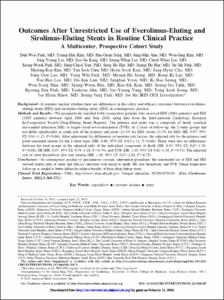KUMEL Repository
1. Journal Papers (연구논문)
1. School of Medicine (의과대학)
Dept. of Internal Medicine (내과학)
Outcomes After Unrestricted Use of Everolimus-Eluting and Sirolimus-Eluting Stents in Routine Clinical Practice A Multicenter, Prospective Cohort Study
- Keimyung Author(s)
- Hur, Seung Ho
- Department
- Dept. of Internal Medicine (내과학)
- Journal Title
- Circulation: Cardiovascular Interventions
- Issued Date
- 2012
- Volume
- 5
- Issue
- 3
- Abstract
- Background—It remains unclear whether there are differences in the safety and efficacy outcomes between everolimus-eluting stents (EES) and sirolimus-eluting stents (SES) in contemporary practice.
Methods and Results—We prospectively enrolled 6166 consecutive patients who received EES (3081 patients) and SES (3085 patients) between April 2008 and June 2010, using data from the Interventional Cardiology Research In-Cooperation Society-Drug-Eluting Stents Registry. The primary end point was a composite of death, nonfatal myocardial infarction (MI), or target-vessel revascularization (TVR). At 2 years of follow-up, the 2 study groups did not differ significantly in crude risk of the primary end point (12.1% for EES versus 12.4% for SES; HR, 0.97; 95% CI, 0.84–1.12, P=0.66). After adjustment for differences in baseline risk factors, the adjusted risk for the primary end point remained similar for the 2 stent types (HR, 0.96; 95% CI, 0.82–1.12, P=0.60). There were also no differences between the stent groups in the adjusted risks of the individual component of death (HR, 0.93; 95% CI, 0.67–1.30, P=0.68), MI (HR, 0.97; 95% CI, 0.79–1.18, P=0.74), and TVR (HR, 1.10; 95% CI, 0.82–1.49, P=0.51). The adjusted risk of stent thrombosis also was similar (HR, 1.16; 95% CI, 0.47–2.84, P=0.75).
Conclusions—In contemporary practice of percutaneous coronary intervention procedures, the unrestricted use of EES and SES showed similar rates of safety and efficacy outcomes with regard to death, MI, sent thrombosis, and TVR. Future longer-term follow-up is needed to better define the relative benefits of these drug-eluting stents.
Key Words: angioplasty
coronary disease
stents
- Keimyung Author(s)(Kor)
- 허승호
- Publisher
- School of Medicine
- Citation
- Duk-Woo Park et al. (2012). Outcomes After Unrestricted Use of Everolimus-Eluting and Sirolimus-Eluting Stents in Routine Clinical Practice A Multicenter, Prospective Cohort Study. Circulation: Cardiovascular Interventions, 5(3), 365–371. doi: 10.1161/CIRCINTERVENTIONS.111.966549
- Type
- Article
- ISSN
- 1941-7640
- Appears in Collections:
- 1. School of Medicine (의과대학) > Dept. of Internal Medicine (내과학)
- 파일 목록
-
-
Download
 oak-aaa-00948.pdf
기타 데이터 / 810.89 kB / Adobe PDF
oak-aaa-00948.pdf
기타 데이터 / 810.89 kB / Adobe PDF
-
Items in Repository are protected by copyright, with all rights reserved, unless otherwise indicated.